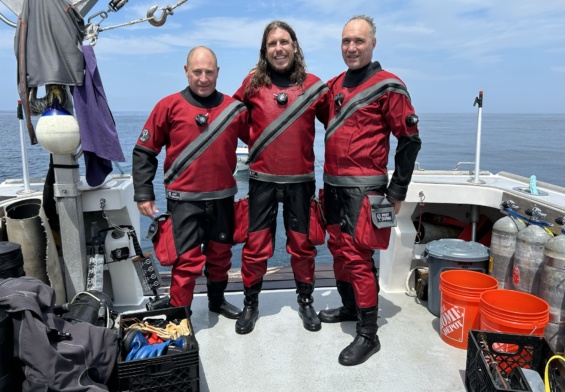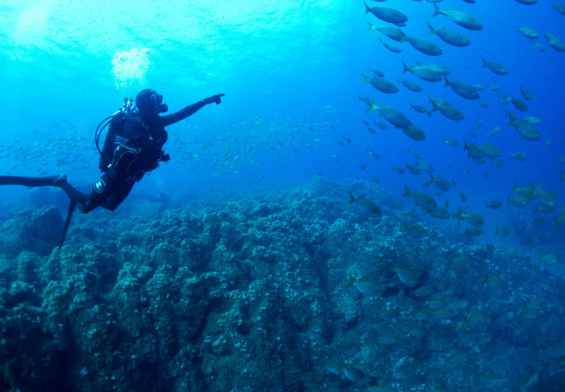By Isabella Furfaro (Underwater model, diving instructor, gold medal at the World championship in “Wide-angle with model” category, in Cuba world championship, 2013)
I read the original article of Giusi Gioffrè published on Serial diver and it was a stimulus to continue to talk about the theme of underwater models and focus on certain aspects of this figure, not always sufficiently highlighted.
It has happened to many underwater models to cross the curious gaze, sometime surprised, of interlocutors who, after a quick glance and a expressed or implied consideration on the physical shape, have asked: who it is, what it does, what should the features be, what role has the model in the world of diving?
In the dictionary of the Italian language a model is “… a person who poses for an artistic purpose or regarding fashion and advertising …and, in common with acting, has to express emotions and feelings in the photographs in which he or she is portrayed …”.
The idea of portraying the human figure underwater, almost certainly, goes back the 40s, in the United States. A talented photographer, who later became famous because of this original initiative, began photographing underwater some American fashion models, the so-called pin-ups, using a underwater camera that he assembled by himself. The photos, originally used for advertising purposes, became an instant hit. Almost simultaneously, in Europe, the Austrian Hans Hass, along with his wife and model Lotte, carried their expeditions and underwater shots that led to the production of famous films and documentaries.
Over time, therefore, the human figure in water became a pleasant complement to the image and the presence of modeling was used in several areas: art, advertising, competitions.
Many photographers portray models in water to highlight the sinuosity and the movement that only water can give to the human body, particularly the female body; in wide-angle pictures the choice of the photographer to introduce harmoniously the human figure in the marine environment is also often linked to the idea to insert an element that gives the perception of size and proportions of the other elements in the image that he or she is composing.
As confirmed by Stefano Proakis – photographer, gold medal with the photo ” Wide-angle with diver” in the World championship of Cuba in 2013 – “… the fact to place the human element, better if it’s female, under the water is not only a technical issue and geometric proportions … “. Proakis believes that “… in the wide-angle photo the female image best harmonizes with the colors and shapes of the marine environment, arousing emotions in the viewer the photo, but also in the photographer that takes it and, therefore, composes …”.
In competitions, especially international ones, the ” wide-angle with diver” photo has become almost a permanent part of the themes that the photographer has to represent, in addition to the classic themes of fish, macro, wide angle.
Often during the competitions is also provided the photo “theme” that the different regulations choose, normally according to the biological characteristics of the seabed where the event is run.
The activity of modeling may begin in a “spontaneous way”, on the basis the relationship of the model with the photographer, friendship, affection, kinship, mere knowledge or sharing of diving. Pose for the photographer can be a game, a casual experience. But it is also true that, at times, occasional experience continues until it becomes a passion, a profession, a sport definite choice.
Other times it happens that the photographer needs to find a valuable assistant who might pose for him and become part of the image he wants to create, participate in the research of subjects and captivating situations and support him with the necessary equipment for purposes both agonistic or professional. In these cases, some photographers are turning to a professional underwater model.
In the various steps, the photographer and the model become a solid team that shares strenuously objectives and results. Unfortunately, the model is often in the shadows, with little recognition for her/his activity and professionalism that is different and not competitive with the photographer’s and should be further enhanced.
On the scene of the Italian underwater photography, especially in the racing field, there have been several skilled models, amongst them Raffaella Schiller, Anna Cipriani, Rosa Donati, Roberta Bedin, Sonia Davino, Giovanna D’Orazio and the undersigned. In close collaboration with their photographers they have contributed, over the years, to bring prestige to the Italian national team and to enrich the medals at various world championships. Titles and medals – many of them gold – made famous the Italian fotosub worldwide.
But can the underwater model be considered an athlete to all effects from a competitive point of view?
The term athlete, from the Latin Athleta and greek ἀθλητής, but also from greek ἆϑλον “race”, refers to the person who practices a sport at a professional level; he/she has a “resistance” that “… it is part of what makes a great athlete …”.
But can the model, fall into this description? May he/she interpret broadly the term “resistance” and include in it in addition to the physical abilities also those related to patience, flexibility, versatility and intuition? Can we think at the model as a figure like the photographer could be the addressee of adequate recognition without being simply an “additional element” of the image or the photographer?
The pictures showed, were taken with the model (the author of this article) posing in apnea (free diving) and with scuba equipment, useful to highlight and suggest that:
- It is important to agree on a sort of “code of gestural communication” between photographer and model. The agreement under water is critical to the outcome of the picture, the model must understand quickly what the photographer wants to communicate and if the mutual knowledge and experience can facilitate this communication, the code makes up for the lack of knowledge and understanding .
- “Acquaticity”, experience and constant training allow the model to optimize the time that the picture must be taken (in the competitions, for example, it is important to save time and air!); the model will have to assess quickly and with the minimal effort permitted by the conditions of the moment: the context in which she/he will be placed in order to better and faster place, the direction and power of the current that affect the position to be taken and the possible maintenance of the same; the most appropriate method of communication with the photographer which is not always easy (poor visibility, extreme distance from the photographer or no eye contact with him; to see reflected the image into the lens – where possible – can be a big help).
The thought of Stefano Proakis
“Vice world champion” and gold medal in the theme “Wide-angle with model/diver ” at the Cuban world championship of 2013
The sea over the centuries has been variously described in its many aspects, with particular reference to its immensity and to the intensity of emotions it arouses. Aspects that have been represented in prose, art, natural sciences and even in philosophy.
The Sea is male, with its strength often impetuous and sometimes destructive. But it is also female, with her way to welcome you, to embrace you , to show its chromatic aspects and the sinuous forms of its coastline and its sea bed that “caress” the curious gaze of the earthlings. It can be said that the photographers seem to welcome the feminine aspect of the Sea.
In underwater photography the wide-angle images represent the more complex type of shot, both from a technical and composition point of view. The wide-angle photos depicting human figures are difficult to interpret and it is easy to make a mistake and take banal and little emotional images: a dark figure with fins which emits bubbles “travelling” within the frame may even seem an intruder, a disturbing element in the picture. To enter the diver in an harmonious and balanced image to portray is a compositional choice that must be weighed both for the size and the position that the diver will occupy in the image.
Proper technique is crucial as, for example, the correct choice in balancing the lights in order to enhance the colours of the foreground subject, the search for attractive shapes or diagonal bottom etc .. The technical aspect and the reference to geometric shapes often do not imply the exaltation of emotions and artistic sense that the photographer might want to pursue.
My choice to avail myself of a wide-angle image of women, lies on the great harmony that have women immersed in water, with their sinuous shapes that are connected with those of the underwater environment, such as, for example, caves and openings of cavities and shapes of rocks, as well as of many marine organisms of the substrate. I often look for this type of environments and for particular forms and combine the harmony of the human figure with the shapes and colours of the underwater environment. I instinctively put the female figure merging smoothly into the picture!
The result I aim is to give emotion and life to photography, to arouse those feelings, an added value, especially in the context of a competition that could make win the image and give at the same time, great satisfaction to the photographer and to the model.
The synergy of the photographer with the model is important, it is hard to understand each other under water; checkmarks have to be decided together previously. It’s also important to have a clear idea of what position has to take the model, who will interpret – as an actress on the stage – the ideas of the photographer; sometimes she places herself correctly in the frame. This comes after many dives done together, after years of collaboration, harmony and mutual respect. Water skills and physical preparation of the model are fundamental and also, as some argue, a good deal of patience and psychological strength to withstand such a heavy commitment.
I am still happy to take wide-angle images, the result of years of study, discussion and work that led me to refine my technique, my style of composition and the strong understanding with the model who follows me since years.





